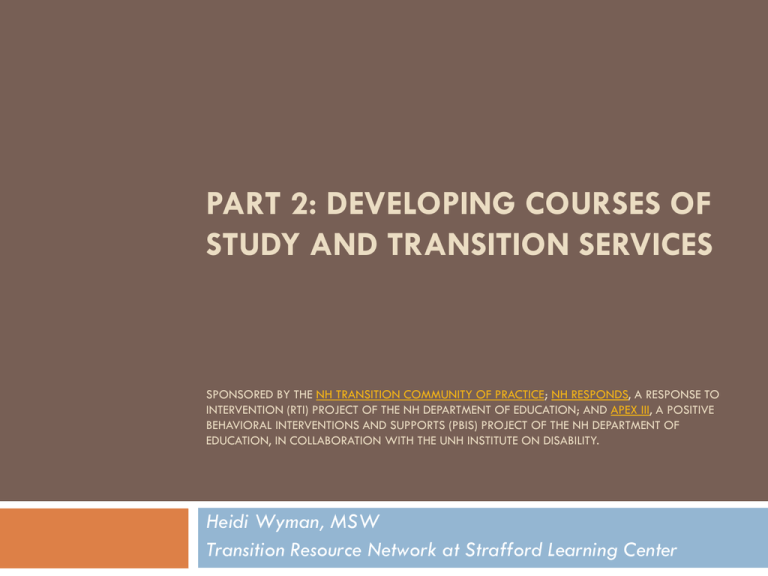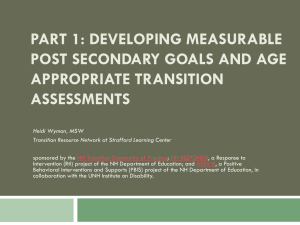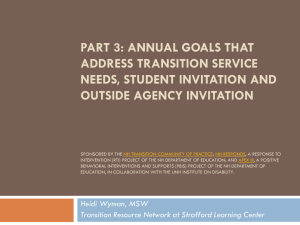PART 2: DEVELOPING COURSES OF STUDY AND TRANSITION SERVICES
advertisement

PART 2: DEVELOPING COURSES OF STUDY AND TRANSITION SERVICES SPONSORED BY THE NH TRANSITION COMMUNITY OF PRACTICE; NH RESPONDS, A RESPONSE TO INTERVENTION (RTI) PROJECT OF THE NH DEPARTMENT OF EDUCATION; AND APEX III, A POSITIVE BEHAVIORAL INTERVENTIONS AND SUPPORTS (PBIS) PROJECT OF THE NH DEPARTMENT OF EDUCATION, IN COLLABORATION WITH THE UNH INSTITUTE ON DISABILITY. Heidi Wyman, MSW Transition Resource Network at Strafford Learning Center Last time… Reviewed definition of MPSGs and Age Appropriate Transition Assessment Looked at three case studies and MPSGs and AATA for each Reviewed some important tips about meeting facilitation, youth engagement and initiating difficult conversations This time…. Definitions New Hampshire Services Case Studies: Review Post Secondary Goals and Age Appropriate Transition Assessments Course of study and transition services Credits & Recognition National Secondary Transition Technical Assistance Center (www.nsttac.org) Dr. Ed O’Leary and the Transition Outcomes Project NH Transition Community of Practice Institute on Disability NH RESPONDS and APEX III projects, and NH Dept of Education Strafford Learning Center Parent Information Center Quick Review of Definitions and Indicator 13 Compliance Course of Study Extended Learning Opportunities and Work-Based Learning Transition Services Outside agencies Indicator 13 Compliance Course of Study is… 6 A multi-year description of coursework to achieve the student’s desired post-school goals from the student’s current to anticipated exit year (Storms, O’Leary, & Williams, 2000) Course of Study NH Rules require that this is in the IEP when the student turns 14 NH Rules also require that vocational classes are included when vocational education is an anticipated pathway The course of study should clearly align with the intended diploma-type and post-secondary goals. If applicable, include ELO, WBL and alternative learning plans. Why Extended Learning Opportunities and Work-based Learning? Important resources for ALL Youth, particularly for many with Disabilities Student struggling for credits or with specific subject matter may be able to earn credits they need WBL (job shadow, internships) provides vital real work experiences Extended Learning Opportunity (E.L.O.) Primary acquisition of knowledge and skills through instruction or study outside of the traditional classroom methodology • • • • • • • Independent study Private instruction Performing groups Internships Community service Apprenticeships Online courses Work-based learning… …is a broad term that covers a variety of structured career exploration and workplace skillbuilding experiences students can have on-site at a workplace. The experiences can range from a simple tour to a months-long internship with regular hours and responsibilities. What’s the Difference? The term “work-based learning” was around long before ELO. Under High School Redesign efforts, WBL is technically a subset of ELO. ELO is assessed by the student showing evidence of competence to a Highly Qualified Teacher Work-based Learning is typically assessed through employer and job support person feedback Transition Services 13 Should focus on academic and functional achievement to facilitate movement from school to post-school life For each postsecondary goal, transition services can include: Instruction Related Services Community Experience Development of Employment and Post-School Objectives Acquisition of Daily Living Skills (if appropriate) Functional Vocational Evaluation (if appropriate) Transition Services Coordination inside school: services Coordination outside school: special ed, guidance, career tech center, work-based learning, related service providers Agencies who are expected to pay MUST BE INVITED with parent or majority age student consent and must agree to provide the service DO NOT include services from an organization that has not agreed to provide them Compliance: what can the school provide? Best practice: Team TO DO list May require an extra meeting or two Include creative thinkers who know the student Connecting with Outside Agencies Area Agency for Developmental Services Vocational Rehabilitation Community Mental Health Services College Disability Support Services Recent evaluations, NOT IEP or coding, is what organizations are looking for to determine eligibility Work collaboratively to determine your regional contact people and process for referral, planning, and meeting participation Indicator 13 Compliance Indicator 13 and IDEA 2004 Transition-driven IEP vs Transition Plan Today will cover IEP elements considered in I13 Checklist items 4&5. Items 6,7&8 (annual goals, student invitation, consent to invite outside agencies) will be covered in Part 3. Case Studies 1. Allison 2. Lissette 3. Lilly 1. Allison’s Post Secondary Goals (Education and Training 1) After graduation from high school, Allison will attend a 4-year Liberal Arts College and take coursework leading to a major in the area of Child Development. (Education and Training 2) The summer after high school, Allison will take a course in first aid and CPR and obtain certification through the local red cross. (Employment 1) After graduation from college, Allison will become an early childhood education teacher in the public schools in her community. (Employment 2) The summer after high school, Allison will work parttime at the child development center near her home. Age Appropriate Transition Assessments •Record of student grades throughout high school, indicating a B average throughout high school (9th through first half of 11th grades) and a statement of how her GPA meets the minimal requirements for entry into college •Scores from curriculum-based measurements that indicate Allison’s level of performance in English and math and a statement describing how her level performance is acceptable for admission into college •A statement by Allison, gathered during an informal interview, recorded on the IEP regarding her interest in attending a university to pursue a degree in Child Development. • a summary of student Psychological test scores obtained during her 3-year reevaluation in the spring of 10th grade indicating specific learning disabilities in reading comprehension and written expression •End of grade test scores from the end of 10th grade demonstrating her participation in the standard course of study with passing scores of 3’s (on a 4-point scale) in reading and math and a statement of how she has met the graduation requirements for statewide testing Transition Services Education and Training Instruction • Instructional support of guided notes for lessons • Instructional support for organization and study skills • Audio-taped texts for English 12 • Extended time on tests in English, Algebra II and Advanced Biology • Modified ACT testing Employment and Other Post School Living Objectives • Job shadow experiences with children • Visit three university campuses, including a tour through the admissions department and a visit to the disability services office, between the late Spring and early Fall • Part time employment in a position related to working with children • Apply for possible college financial aid • Vocational rehabilitation referral to determine eligibility for tuition assistance • Apply for college and disability support service, no later than December Allison’s Transition Services in NHSEIS Course of Study Psychology (semester) English 12 (year) Algebra II (year) Band (year) Phys Ed. (semester) Cooperative Work Experience (semester) Advanced Biology (year) Child Development (semester) Resource Room (year) Allison’s Course of Study in NHSEIS What’s wrong with transition services or course of study like this? Services: • Complete application process at community college • Job shadowing at local fast food restaurant • Referral to Developmental Disabilities Services Course of Study Occupational English, Occupational Mathematics , Life Skills Science, Social Studies I (Government/US History), II (Selfadvocacy/Problem solving), Computer proficiency as specified in IEP, Health and Physical Education , Career Technical Education, Occupational Preparation 2. Lissette’s Current Post Secondary Goals Education and Training 1) After graduation from high school, Lissette will attend the Workforce Development Program and complete a non-degree program in food service at Montgomery County Community College 2) After high school, Lissette will participate in weekly instruction on independent living skills at Area Agency for developmental services. Employment 1) After high school, Lissette will work on campus part-time in the food court at the college with supports from Vocational Rehabilitation and the staff at the college. 2) After completion of the Workforce Development Program at Montgomery County Community College, Lissette will work as a prep cook at a local restaurant near her home with time-limited supports provided by the Area Agency. Independent Living 1) Upon completion of high school, Lissette will utilize public transportation, including the public bus and uptown trolley with time limited supports provided through Vocational Rehabilitation. (2) After high school, Lissette will live semi-independently with a roommate in a assisted living apartment with supports provided through Area Agency. Lissette’s Age Appropriate Transition Assessments Classroom observation notes monthly August 2005 – April 2006; Community Based Instruction (community and work activities) task analysis checks August 2005 – April 2006”, Transition Planning Inventory, student, home, and school forms, April 2006; Making Action Plans [MAPS] (Forest & Lusthaus, 1990), completed May, 2005 Lissette’s Transition Services Instruction Instruction on Community Safety skills Travel instruction Math instruction related to money usage Literacy instruction related to sight word identification Instruction related to community safety and self defense at the YMCA Math instruction related to telling time on a variety of watches and clocks Related Service Assistive technology services to increase use of voice output device Physical therapy to improve independent ambulation Employment and Other Post School Living Objectives Purchase a monthly bus pass Safety skills in the community Learning to choose a seat near the bus driver Learning to use the pull cord to identify her upcoming stop Lissette’s Transition Services in NHSEIS Lissette’s Course of Study Functional Math I, II, III, IV (4 Credits) Functional Reading I, II, III, IV (4 Credits) Introduction to Cooking I, II, III, IV (4 Credits) Safety in the Community I, II, III, IV (4 Credits) Recreation Leisure I, II, III (3 Credits) Work Study Skills I, II, III, IV (4 Credits) Lissette’s Course of Study in NHSEIS What’s wrong with this course of study? What could the team so with these services? Course of Study English I, II, III, IV (4 Credits); Mathematics (Algebra I, Algebra II, Geometry, and higher level math course) (4 Credits), Science (Physical Science, Biology, Earth/Environmental Science) (3 Credits) Social Studies (Civics and Economics, US History, World History) (3 Credits), Second Language (2 Credits), Computer skills (1 Credit) Health and Physical Education (1 Credit) Electives (3 Credits) Transition Services: • Purchase a monthly bus pass • Safety skills in the community • Learning to choose a seat near the bus driver • Learning to use the pull cord to identify her upcoming stop 3. Lilly’s Current Post Secondary Goals Education and Training After graduation, Lilly will participate in an area agency-based program with an adult curriculum focused on gaining maximum social communication, daily living, and vocational skills. Employment After graduation, Lilly will participate in an area agency-based program with an adult curriculum, receiving services to increase her stamina and mobility to prepare her for work. Independent Living After graduation Lilly will use an augmentative communication device at home and the area agency based program to communicate her wants, needs, and desires and to interact with her environment more independently. Lilly’s Age Appropriate Transition Assessments Anecdotal records for an observation period of 10 days A portfolio assessment Notes in the permanent folder document regarding augmentative communication devices since elementary age Results of a physical therapy evaluation Signed examination summary from Lilly’s pediatrician, dated during the current year Lilly’s Transition Services Instruction Self-care skill instruction Instruction in use of augmentative devise Functional Vocational Evaluation Refer to Vocational Rehabilitation for non-verbal, modified assessments of adaptive behavior, mobility, dexterity Ecological Assessment Community Experience Community-based independent and community living instruction Visits to recreational agencies/facilities in the community Post school living Related Services Assistive technology evaluation and selection of appropriate device for school and post school environments Speech therapy services for training in use of augmentative communication device Occupational therapy for use of assistive technology Physical therapy to maintain and improve strength and flexibility Nursing services to increase Lilly’s ability access to community environments Leisure and recreational interest survey through student response to different leisure opportunities in the community Meeting with SSI representative to determine possible financial benefits Lilly’s Transition Services in NHSEIS Course of Study Career/Technical (2 credits), Life Skills (2 credits), Elective (Chorus) (1 credit) Lilly’s Course of Study in NHSEIS What’s wrong with a course of study or transition services as follows? Course of Study A list of general curriculum courses, noting use of extended content standards. Community Experience Class trip to Disability Services at the local college Related Services Speech therapy to improve Lilly’s verbal communication skills Questions about the content? Contact: Heidi Wyman, MSW Strafford Learning Center 317 Main Street Somersworth, NH 03878 hwyman@slc.k12.nh.us 603.692-4411 ext. 41

